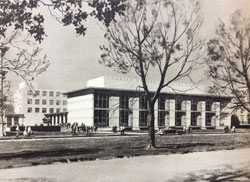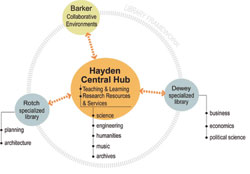
| Vol.
XXVII No.
1 September / October 2014 |
| contents |
| Printable Version |
Redesigning Hayden Library and the
Future of Library Spaces at MIT
“In the applications of technological process to intellectual expansion, there lies a natural field of leadership for MIT. Accordingly, the Hayden Library will provide a laboratory in which these and other processes can be explored.” – The Charles Hayden Memorial Library, 1946, page 13
These words were written with a sober but lofty confidence at the dawn of the post-war era in a brochure outlining MIT’s ambitious plans for its new central library, the Charles Hayden Memorial Library. Designed to serve as an “integrating force” at the Institute, the Hayden Library inaugurated the expansion and modernization of MIT’s academic facilities. MIT collaborated with architect Ralph T. Walker (class of 1911) in developing a plan for the library that stressed “maximum flexibility.” This meant both creating a building that allowed for potential future restructuring of the library system, and designing spaces that serviced scholarship of the humanities and the sciences with equal proficiency. It was this future orientation that allowed the library to smoothly adapt to the staggering technological changes of the second half of the twentieth century.

The building has adapted to programmatic changes as well. The library has always housed the humanities and science collections, as well as a music library. But a space that once served as a gallery now houses Killian Hall (a heavily-used performance venue), while an area that originally contained an open-stacks facility is now firmly secured, and houses the unique historic materials administered by the Institute Archives and Special Collections. Despite these changes the Hayden Building, now over 60 years old, requires significant investment to renew the building infrastructure, and to exhibit the necessary flexibility going forward so that the Libraries’ program will continue to meet the needs of current and future faculty and students. The necessary redesign of Hayden provides an opportunity more generally to rethink library spaces across campus.

In the fall of 2011, with the support of the Faculty Committee on the Library System (FCLS) and the Committee for the Review of Space Planning Program (CRSP), the Libraries and Campus Planning and Design engaged the architecture firm Shepley Bulfinch to develop a framework for space planning in the Libraries over the next five to 10 years. Completed in June 2012, this Phase One report envisions library spaces in Hayden (Building 14) as the hub of the library system, providing a rich mix of learning environments and collections for science, engineering, humanities, music, and archives. It endorses the concept of Hayden becoming a library centric academic village. To complement the remodel of Hayden, the focus of the Barker Library in the dome of Building 10 will become 24-hour spaces with a rich mix of quiet study, collaborative, and instructional spaces, but largely without tangible collections or a traditional staffed service point.
Two specialized facilities meeting the needs of their campus neighborhoods will remain: Rotch in Building 7, serving architecture, art, and planning; and Dewey in E53, serving management, economics, and political science. Such a strategic shift will strengthen the Libraries ability to support and enhance the academic priorities of the Institute.
Upon completion of this study, CRSP then launched a Rapid Response Building Assessment Study of Building 14 as part of its Accelerated Capital Renewal Program. The study documented numerous capital renewal needs to be addressed including accessibility, safety, and infrastructure (elevators, mezzanines, lack of restrooms, HVAC, building envelope). With this study in hand along with the Shepley Report, CRSP approved the launch of Phase Two of library space planning last fall. After a competitive bidding process during spring 2014, MIT selected the firm of Shepley Bullfinch and Van der Weil Engineering to create conceptual and schematic designs for a series of phased renovations that will respond to both program and capital renewal needs within Hayden Library. Funding for the capital renewal and some renovations to support new programmatic uses of the Hayden Library space are a priority in the Institute’s Capital Plan. The project will also create conceptual designs for targeted renovations to Barker Library's 5th floor perimeter and upper floors (building on the hugely successful renovation and restoration of the 24x7 reading room), and improvements to Rotch Library. The conceptual designs for Barker and Rotch will enable us to propose projects to CRSP for future funding.
Over the summer the project team has engaged in a number of meetings with faculty, students, and staff to solicit program ideas for library spaces with a particular focus on Hayden Library. Programming for Phase Two will be informed by the Libraries' strategic plan, MIT's CRSP and Capital Renewal processes, MIT's 2030 campus planning effort, MIT's upcoming Capital Campaign fundraising efforts, and MIT's new Innovation and Future of Education initiatives. Feasibility and impact of early concepts ideas will be shared and tested through feedback from the MIT community and library staff. The Libraries will be creating a Website early in the fall term to keep the community informed of the project’s progress. The Faculty Committee on the Library System will play a key role in providing input, and ensuring broad participation in the process. We welcome your ideas and observations as we continue this process; please feel free to send both of us your thoughts at the e-mail addresses listed below.
| Back to top | |
| Send your comments |
| home this issue archives editorial board contact us faculty website |